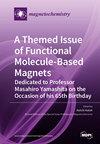Two One-Dimensional Copper-Oxalate Frameworks with the Jahn–Teller Effect: [(CH3)3NH]2[Cu(μ-C2O4)(C2O4)]·2.5H2O (I) and [(C2H5)3NH]2[Cu(μ-C2O4)(C2O4)]·H2O (II)
IF 2.5
4区 化学
Q2 CHEMISTRY, INORGANIC & NUCLEAR
引用次数: 0
Abstract
Two one-dimensional oxalate-bridged Cu(II) ammonium salts, [(CH3)3NH]2[Cu(m-C2O4)(C2O4)]·2.5H2O (I) and [(C2H5)3NH]2[Cu(m-C2O4)(C2O4)]·H2O (II) were obtained and characterized. They were composed of ammonium: (CH3)3NH+ in (I), (C2H5)3NH+ in (II), [Cu(m-C2O4)(C2O4)2−]n and H2O. The Jahn–Teller-distorted Cu(II) is octahedrally coordinated by six O atoms from three oxalates and forms a one-dimensional zigzag chain. The hydrogen bonds between ammonium, the anion and H2O form a three-dimensional network. There is no hydrogen bond between the anion chains. They were insulated at 20 °C with a relative humidity of 40%. Ferromagnetic and weak-ferromagnetic behaviors were observed in I and II, separately. No long-range ordering was observed above 2 K.具有Jahn-Teller效应的两种一维草酸铜骨架:[(CH3)3NH]2[Cu(μ-C2O4)(C2O4)]·2.5H2O (I)和[(C2H5)3NH]2[Cu(μ-C2O4)(C2O4)]·H2O (II)
制备了两种一维草酸桥接Cu(II)铵盐[(CH3)3NH]2[Cu(m-C2O4)(C2O4)]·2.5H2O (I)和[(C2H5)3NH]2[Cu(m-C2O4)(C2O4)]·H2O (II)并进行了表征。它们由(CH3)3NH+ in (I)、(C2H5)3NH+ in (II)、[Cu(m-C2O4)(C2O4)2−]n和H2O组成。jhn - teller -畸变Cu(II)由来自三种草酸盐的六个O原子八面配位并形成一维之字形链。铵、阴离子和水之间的氢键形成了一个三维网络。阴离子链之间没有氢键。它们在20°C和40%的相对湿度下绝缘。在I和II中分别观察到铁磁性和弱铁磁性行为。在2 K以上没有观察到长程排序。
本文章由计算机程序翻译,如有差异,请以英文原文为准。
求助全文
约1分钟内获得全文
求助全文
来源期刊

Magnetochemistry
Chemistry-Chemistry (miscellaneous)
CiteScore
3.90
自引率
11.10%
发文量
145
审稿时长
11 weeks
期刊介绍:
Magnetochemistry (ISSN 2312-7481) is a unique international, scientific open access journal on molecular magnetism, the relationship between chemical structure and magnetism and magnetic materials. Magnetochemistry publishes research articles, short communications and reviews. Our aim is to encourage scientists to publish their experimental and theoretical results in as much detail as possible. Therefore, there is no restriction on the length of the papers. The full experimental details must be provided so that the results can be reproduced.
 求助内容:
求助内容: 应助结果提醒方式:
应助结果提醒方式:


